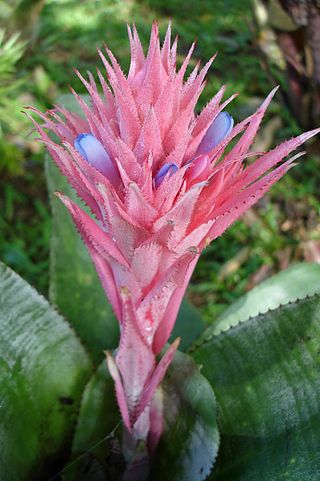
Aechmea is a genus of flowering plants in the family Bromeliaceae. The name comes from the Greek aichme, meaning "spear". Suggested pronunciations include EEK-me-ə and eek-MEE-ə. Aechmea comprises eight subgenera and around 250 species distributed from Mexico through South America and the Caribbean. Most of the species in this genus are epiphytes.
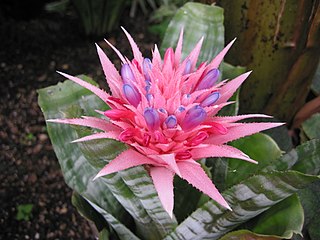
Aechmea fasciata is a species of flowering plant in the Bromeliaceae family. It is commonly called the silver vase or urn plant and is native to Brazil. This plant is probably the best known species in this genus, and it is often grown as a houseplant in temperate areas.

Aechmea pineliana is a flowering plant in the family Bromeliaceae. It is typical of Atlantic Forest vegetation in Brazil, specially in following states: Espírito Santo, Minas Gerais, and Rio de Janeiro. This plant is cited in Flora Brasiliensis by Carl Friedrich Philipp von Martius, and it is often used as an ornamental plant.
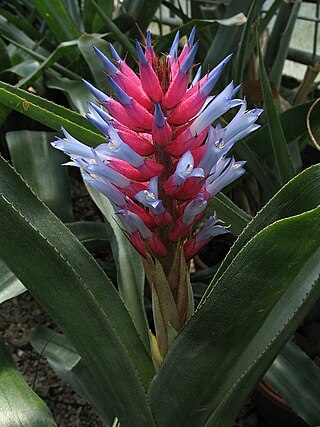
Ronnbergia wuelfinghoffii is a species of flowering plant in the family Bromeliaceae, native to western Colombia and Ecuador. It was first described in 1998 as Aechmea wuelfinghoffii. Its natural habitat is subtropical or tropical moist lowland forests. It is threatened by habitat loss.
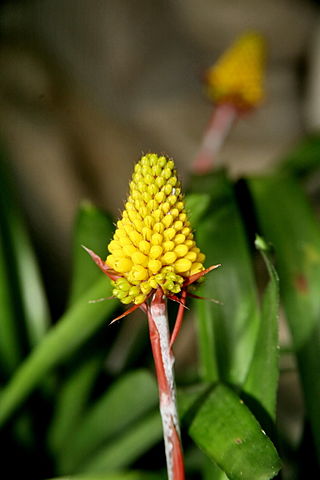
Aechmea calyculata is a species of flowering plant in the Bromeliaceae family.
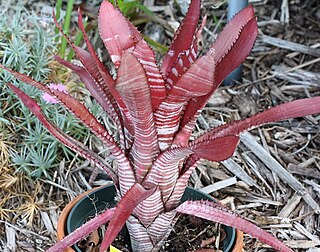
Aechmea phanerophlebia is a species of flowering plant in the Bromeliaceae family. This species is endemic to Brazil.

Aechmea comata is a species of flowering plant in the Bromeliaceae family. This species is endemic to southern Brazil.

Aechmea ornata is a species of flowering plant in the Bromeliaceae family. It is endemic to southern Brazil from Rio de Janeiro State south to Santa Catarina.

Aechmea pectinata is a species of flowering plant in the Bromeliaceae family. This species is endemic to southeastern Brazil, from Rio de Janeiro State south to Santa Catarina.

Aechmea sphaerocephala is a species of flowering plant in the Bromeliaceae family. It is endemic to southeastern Brazil, known from the States of Espírito Santo and Rio de Janeiro.
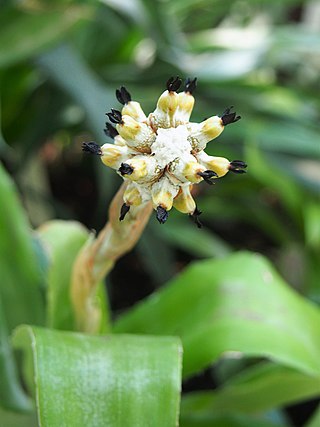
Aechmea squarrosa is a species of flowering plant in the Bromeliaceae family'. This species is endemic to the State of Rio de Janeiro in southeastern Brazil.

Aechmea miniata is a species of flowering plant in the Bromeliaceae family. This species is native to the state of Bahia in eastern Brazil.

Aechmea magdalenae is a flowering plant in the Bromeliaceae family. It is also known as ixtle. This species is native to Central America, southern Mexico, Colombia and Ecuador. The specific epithet magdalenae comes from the place it was discovered, the Rio Magdalenae Valley in Colombia. The long green leaves feature fierce spines and may reach about 2.5 meters tall. In nature, it is found in moist and swampy woods. The flowers are red and give way to edible fruits.

Aechmea penduliflora is a species of flowering plant in the Bromeliaceae family. It is native to Central America and northern South America.

Aechmea servitensis is a species of flowering plant in the Bromeliaceae family. It is native to Ecuador and Colombia.
Aechmea contracta is a species of flowering plant in the Bromeliaceae family. It is native to Venezuela, Colombia, Peru, Guyana and northern Brazil.

Aechmea pubescens is a species of flowering plant in the Bromeliaceae family. This species is native to Costa Rica, Honduras, Nicaragua, Panama, Colombia and Venezuela.

Aechmea tocantina is a species of flowering plant in the Bromeliaceae family. This species is native to northern and central South America.
Aechmea vallerandii is a species of flowering plant in the genus Aechmea. This was for a time called A. beeriana but was reclassified in 2008. It is native to Panama and to northern South America.

Karawata is a genus of flowering plant in the family Bromeliaceae, native to eastern Brazil. The genus was first described in 2019.


















